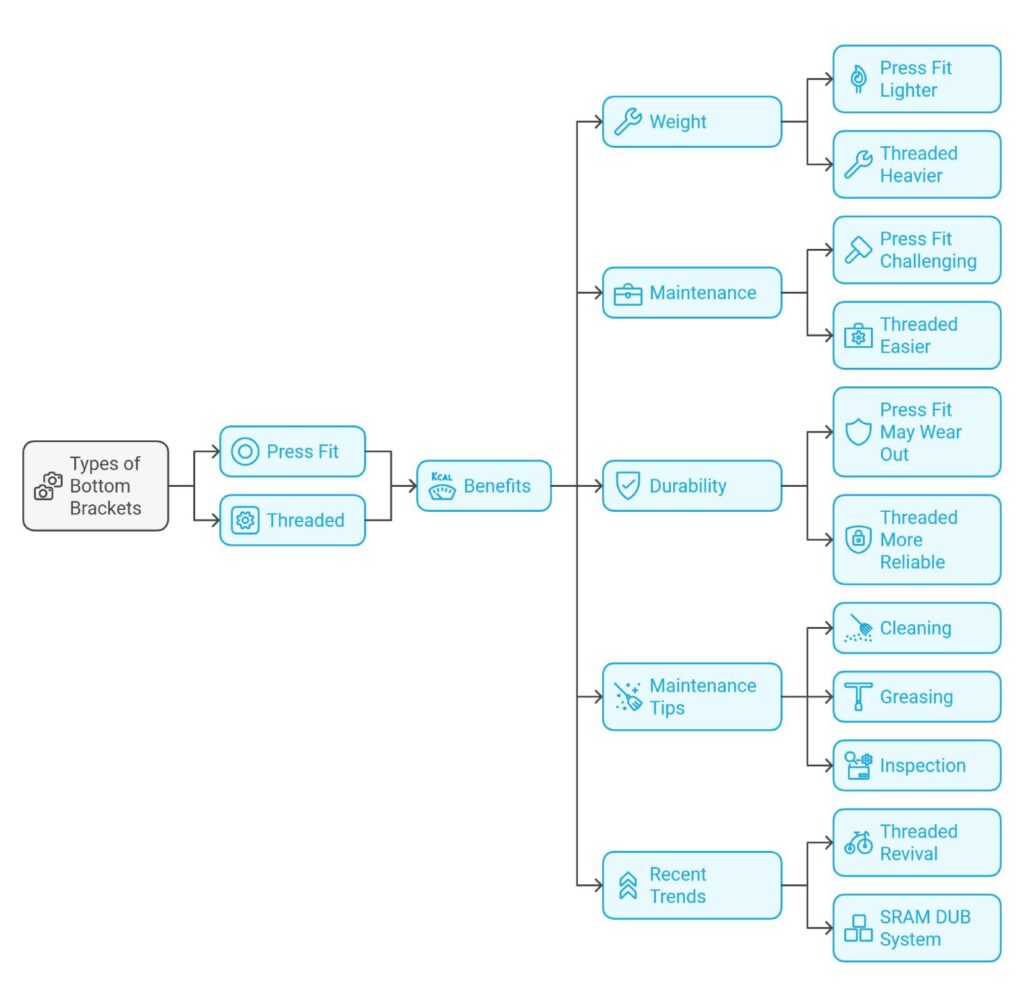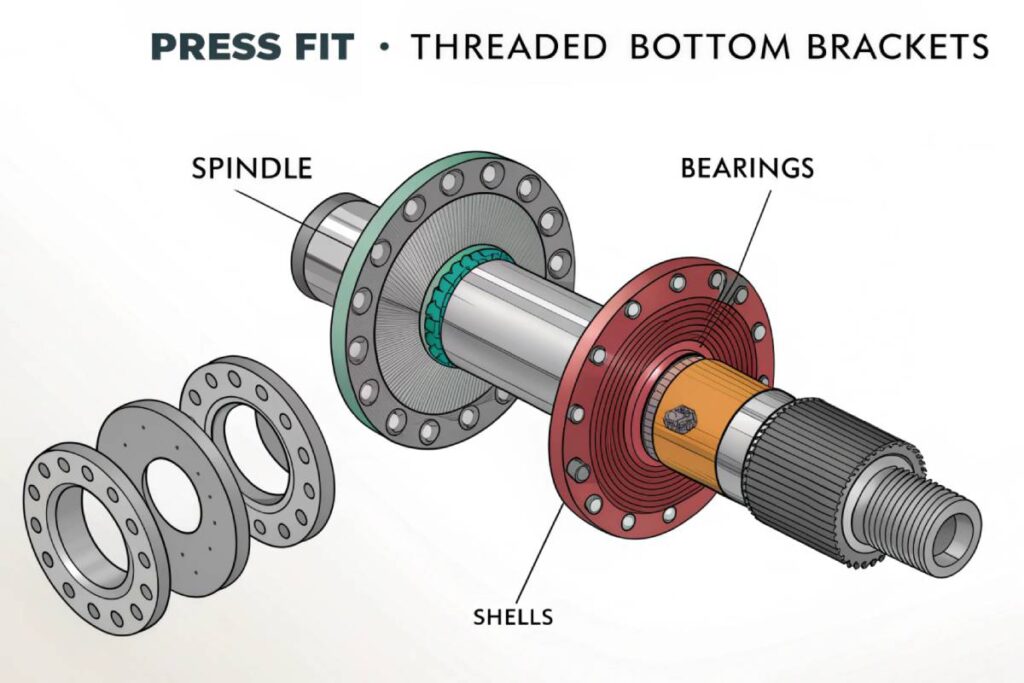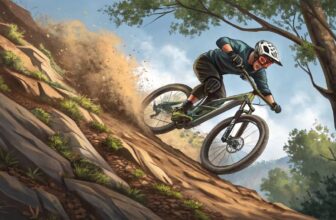Are you ready to elevate your mountain biking experience? Selecting the right MTB bottom bracket is crucial for performance, durability, and overall ride quality.
Whether you’re a seasoned trailblazer or just hitting the rugged paths, understanding the nuances between press fit and threaded bottom brackets can make all the difference.
Dive into our comprehensive guide where we unravel the heart of your bike, explore groundbreaking innovations, and provide expert tips to keep your ride smooth and efficient.
Let’s pedal into the essentials that will keep you conquering every trail with confidence and style!

Evolution of Mountain Biking
Since its early days, mountain biking has seen some mighty changes, transforming into a sport that’s not just for thrill-seekers but for everybody looking to spin their wheels on some rugged paths. Let’s take a pedal-down memory lane to explore some wild innovations that reshaped this high-adrenaline activity, making it as inviting as your grandma’s cookies—alright, maybe with a bit more grit.
Game-Changing Innovations
Think mountain biking’s a smooth ride? It wasn’t always that way! The sport’s history is paved with techy wizardry, with significant inventions fixing problems you never knew existed. Take, for example, the Horst-link suspension design, a genuine game-changer introduced by Horst Leitner back in 1985.
This innovation cuts down on braking forces screwing up suspension performance. Big names like Specialized and Norco hopped on this train, and it’s been a bike shop staple ever since.
Spin the wheel of time to the ‘90s, and you’ll find disc brakes muscling their way into the scene. If you fancy a brake that doesn’t care about muddy trails or wet leaves, this was nothing short of biking sorcery. Hope Technology and Shimano cracked the code with hydraulic disc brakes around 1999. They made sure your stopping game was as strong as your peddlin’.
Then there’s the dawn of the 29-inch wheels. When Wilderness Trail Bikes rolled out the first one in 1999, the biking world saw better grip and easier rollovers—like gliding over tiny mountains. These wheels have become fan favorites, and for good reason.
Shifting to Mainstream
The first glimpse of mountain biking entering the all-access zone was in 1981 with the launch of the Specialized Stumpjumper. This was the first time folks could easily snag a bike built just for off-road thrills. No more jerry-rigging your road bike for that.
With innovation fueling the sport, mountain biking started chillin’ in the mainstream. Introduced tech, like hydraulic disc brakes and those big ol’ 29-inch wheels, took the sport to new heights (and depths) of performance. Not to mention advanced suspension systems that allowed even novice riders to navigate tricky terrains like pros.
Oh, and don’t forget about those bottom brackets. New types like Press Fit and Threaded are making pedals more efficient and bikes lighter. Canyon shook things up in 2022 with its Endurance range using the BB86 press-fit bracket, giving riders a sleek, mighty pedal action.
Getting clued into these innovations isn’t just for bragging rights. It helps newbies and veterans choose gear that’ll perform best in their mountain bike quests. If you’re contemplating the latest bike components, our guide on the best mountain bikes under $1000 is there to point you in the right direction.
Suspension Technology
These days, mountain bikes are like magic carpets on wheels, thanks to snazzy suspension systems that boost performance, get you comfy, and keep you steady on the trails. Let’s break down two-star players in the suspension lineup: Horst-Link suspension design and what happens when you hit the brakes.
Horst-Link Suspension Design
Back in ’85, Horst Leitner whipped up something radical—the Horst-Link suspension. His design took a bite out of the problem caused by braking forces, letting folks glide over bumpy trails with ease. How does it work? Simple! It adds a pivot near the rear wheel axle, shrugging off the braking forces to keep the suspension doing its thing.
Plenty of big names in biking have jumped on the Horst-Link bandwagon:
- Specialized
- Norco
- Transition
| Brand | Model | Horst-Link Suspension |
|---|---|---|
| Specialized | Stumpjumper | Yep |
| Norco | Sight | Yep |
| Transition | Sentinel | Yep |
Curious about dialing in your suspension just right? Check out our handy mtb suspension setup guide.
Impact of Braking Forces
Ever hit the brakes and felt like the bike might nosedive? Yeah, braking forces can pour cold water on your suspension’s parade. Slamming those brakes squashes the front suspension, messing with your ride. Enter Horst-Link, the hero that keeps traction steady and your ride smooth as you rumble over rocky paths.
These swanky suspension systems have changed the game, sidestepping those pesky braking effects and giving cyclists better control and balance —a killer combo when teamed up with top-notch brakes.
Grasping how braking shakes up the suspension can help bikers rock their ride even more. Interested in comparing braking systems? Have a peek at our mountain bike brakes comparison.
Today’s techy upgrades in suspension mean mountain biking is a lot more gripping, literally and figuratively. With better stability and ease, riders—especially the newbies—can choose their dream bike with a clearer vision, transforming every adventure into an epically smooth jaunt.
Curious about mastering those cycling basics? Traverse over to our mountain biking basic skills guide.
Advancements in Braking Systems
Mountain biking has seen some pretty cool upgrades over the years, especially in the braking department. These breakthroughs have made bikes easier to handle, safer, and just better all around. Let’s dive into two game-changing innovations: disc brakes and hydraulic rim brakes.
Introduction of Disc Brakes
Disc brakes were a total game changer in the mountain biking scene. When Shimano rolled out their XT M755 disc brakes in 1999, it was like switching from dial-up to high-speed internet. These brakes use a rotor bolted to the wheel hub and calipers with pads that clamp down on the rotor to stop the bike.
Key Benefits:
- Strong Stopping Power: Disc brakes bring lots of oomph, which is a lifesaver when trails are tricky or the weather’s a pain.
- Smooth Control: Riders can nail the exact amount of brake they need, making for smoother and more predictable stops.
- Rain, Mud, No Problem: Disc brakes don’t flinch in wet and slushy conditions, unlike wimpy rim brakes.
| Feature | Disc Brakes |
|---|---|
| Stopping Power | Top-notch |
| Performance when Wet | Always reliable |
| Modulation | Spot on |
| Weight | A touch heavier than rim brakes |
Curious about how different brakes measure up? Check out our mountain bike brakes comparison page.
Hydraulic Rim Brakes
Magura first brought hydraulic rim brakes into the scene in 1987, and they became a hit with trial bikers because you could lock the wheel on a dime using hydraulic magic. Instead of cables yanking the brake, hydraulic fluid steps up, delivering a smoother and stronger braking experience.
Key Benefits:
- Reliable Wheel Locking: Gives riders some serious control with a predictable wheel lock.
- Strong Braking Power: Packs quite the punch when stopping, ideal for tricky rides.
| Feature | Hydraulic Rim Brakes |
|---|---|
| Stopping Power | Pretty powerful |
| Performance When Wet | Not as hot compared to disc brakes |
| Modulation | Pretty good |
| Maintenance | Needs regular love like bleeding and fluid checks |
Though they were all the rage initially, hydraulic rim brakes are now a rare species in mountain biking thanks to the superior performance of disc brakes, which are just better overall in handling different conditions.
Want to keep your ride in tip-top shape? Take a look at our guides on mountain bike maintenance and MTB gear ratios.
Getting up to speed on how braking systems have evolved and what each type brings to the table can help you pick the right setup for your bike. And for tips on keeping your brakes in peak condition, don’t miss our DIY mountain bike repairs article.
Tire Size Trends
Digging into tire sizes can reveal a lot about how mountain biking is changing up its game. One hot topic? The 29-inch wheels. They’ve been a game-changer for both weekend warriors and hardcore pros.
Adoption of 29-Inch Wheels
Flashback to 1999 when Wilderness Trail Bikes (WTB) popped out the first 29-inch tire, shaking things up in the mountain biking scene. Back then, 26 inches was the standard. But the new wheels, known as “29ers,” kicked things up a notch, promising smoother rides and better control over tricky trails.
Benefits of Mountain Biking
Swapping out those 26-inch wheels for 29ers comes with some serious perks that have won over a lot of riders. Here’s the scoop:
1. Improved Grip and Traction
29ers’ bigger surface area hugs the ground tighter, giving you better grip and traction. This is a huge win in mountain biking, especially when you’re tackling wild and uneven terrains.
2. Enhanced Rollover Capability
Say goodbye to stalling out over roots and rocks. These bigger wheels handle obstacles much better. Their larger size levels out bumps, keeping your speed steady as you barrel down tricky slopes.
3. Increased Stability
Riders can’t stop raving about how stable these wheels are, especially when they’re booking it down trails. Whether you’re an old hand or a newbie, you’ll find that stability is key when the path gets complicated.
4. Smoother Ride
Less jarring, and more riding. The 29ers smooth out those pesky bumps and holes, making long rides less tiring. It’s like gliding instead of grinding.
5. Better Handling in Corners
There’s a common myth that bigger wheels mean clumsy handling. Not with 29-inch wheels. They grip turns like a pro, offering a balanced mix of stability and precision, no matter the riding style—from rapid fires down hills to twisty single-track paths.
| Benefit | Advantage |
|---|---|
| Improved Grip | Better traction on wild terrains |
| Enhanced Rollover | Smooth gliding over obstacles |
| Increased Stability | Solid and steady at high speeds |
| Smoother Ride | Glide effortlessly over uneven ground |
| Better Handling | Nail those corners with ease |
29-inch wheels have really changed how folks ride out there in the dirt. And for those always looking to up their game, there’s stuff to dive into like mountain bike maintenance, mtb gear ratios, and mtb suspension setup. These might just give you that extra edge to keep the ride exciting and safe.
Bottom Bracket Types
Picking the right bottom bracket for your mountain bike is like choosing the heart of your ride. Two main contenders stand out: press fit and threaded brackets. Knowing what sets them apart can help you pick the best ride buddy for your bike.

Press Fit vs Threaded
Press Fit Bottom Brackets
Press fit bottom brackets hang out right inside the frame’s bore. They’re lightweight champs, shaving off some grams for the frame too. But keep an eye on them, because they can throw tantrums when under stress, possibly bruising the frame. Treat them well, and these brackets can clock in between 8,000 km and 29,000 km or more without fuss.
Threaded Bottom Brackets
Threaded bottom brackets are tough and pretty chill to maintain. They basically screw right into the frame for a snug fit that’s always ready to be tightened when needed. Setting them up is a DIYer’s dream—just basic tool vibes here. As for longevity, they’re like old-school prop machines; some can outlast 40,000 km journeys on vintage bikes, though others might wave goodbye at 5,000 km on newer bikes.
| Feature | Press Fit Bottom Brackets | Threaded Bottom Brackets |
|---|---|---|
| Weight | Featherweight vibes | A bit more meat on the bones |
| Frame Love | Fit for lighter frames | Cuddles more solid frames |
| Install Game | Pops in | Screws in securely |
| Tools Needed | Snazzy stuff | Basic toolbox fix |
| Maintenance | Needs some TLC | DIY-friendly fun |
| Durability | 8,000 – 29,000 km | 5,000 – 40,000 km |
| Issues | May wine and dine with wear | Can be tightened post-wear |
Maintenance and Durability
A little love goes a long way in keeping these parts grooving smoothly. It doesn’t matter if it’s press fit or threaded—check them regularly, and they’ll stay fresh. For more pointers on keeping your mountain bike in top shape, you might want to peek at our mountain bike maintenance article.
Both press fit and threaded bottom brackets come with their own quirks and perks. Size up what fits your ride style and the trails you tear up. Whether it’s your first pedal push or if you’re a seasoned trailblazer, knowing these bits can keep your bike rolling beautifully for the long haul.
Want to geek out more on how your MTB parts all line up? Cruise through our guides on mtb drivetrain compatibility and mtb bearing replacement.
Threaded Bottom Brackets
Threaded bottom brackets have been a trusty choice in mountain biking, known for their ruggedness and reliability for riders of all skill levels. Let’s take a closer look at the nitty-gritty of these systems, their perks, and their not-so-great sides.
Thread Specs
These bottom brackets play it by the book to make sure everything fits like a glove and lasts the distance. Here’s the scoop:
- BSA (British Standard Cycle): Think of this as the go-to style, also called English threading. It measures 1.37 inches in diameter and has 24 threads per inch (TPI). It’s the most popular option and works with many frames.
- Italian Threading: A bit unique when compared to BSA, Italian threading is 36mm across with the same 24 TPI. The twist? The right side cup tightens clockwise, unlike the BSA’s left-hand twist.
Pros and Cons
Threaded bottom brackets have their ups and downs. Knowing these helps when choosing upkeep strategies and upgrades for your mountain ride.
Pros
- Built to Last: These brackets are tough cookies. They hold up well and don’t need swapping out too often.
- Easy Peasy Maintenance: Part of why they’re loved is because swapping them out or tinkering with them is a breeze. Riders can bust out a couple of tools and handle things on their own.
- Budget-Friendly: Compared to press-fits, they won’t break the bank in terms of upkeep and don’t need a bunch of fancy gadgets.
- Solid Fit: They screw in nice and tight, stopping those annoying squeaky sounds and preventing them from coming loose down the road.
Cons
- A Tad Hefty: The brackets and frames can be a smidge on the heavy side, but not enough to make a real fuss over.
- Dragged-Out Fabrication: Getting the bracket shell ready can be a bit more of a hassle, taking extra time and coins for makers.
- Won’t Work Everywhere: Not every shiny new bike model likes threaded brackets, so some folks might eye press-fit alternatives.
| Trait | Threaded BB | Press Fit BB |
|---|---|---|
| Durability | High | Medium |
| Ease of Installation | DIY-friendly | Needs special gear |
| Weight | Heavier | A little lighter |
| Cost of Maintenance | Low | High |
| Frame Compatibility | Not in all new bikes | Quite trendy in new bikes |
When it comes down to picking the right bottom bracket for your mountain bike, think about how you like to ride, how comfortable you are with tinkering, and what kind of frame you have. Check out more about mountain bike maintenance and mtb drivetrain compatibility to keep you and your bike happy on the trails.
Press Fit Bottom Brackets
Deciding on an MTB bottom bracket? Press fit ones are in the spotlight, offering benefits but also their own quirks. Grasping how they work and handling typical problems can steer cyclists right.
Press Fit Magic
Press fit bottom brackets are all about snug fits. No threads here – just a tight squeeze into the bike’s bottom bracket shell. This design is great for manufacturers since it cuts down production steps and costs. Just shove it in and you’re good to go – sort of.
| Factor | Press Fit Bottom Brackets |
|---|---|
| How It Goes In | Pressed into frame |
| What It Needs | Super precise matching of frame and bracket |
| Keeping It Tip-Top | Special tools for fitting and removal |
Getting it in place means using particular gizmos to squish the bracket just right. This skips the faff of threading, which is music to the ears of cost-conscious bike makers.
Bumps in the Road and Fixes
They’re nifty, but press fits aren’t without bumps:
Problem: Annoying Rattles
Stress can mess up that snug fit over time, causing rattling noises. Not fun on a serene ride.
Fix:
Keep an eye (and ear) out. Make sure everything’s clean, greased, and in order when fitting. If the racket refuses to quit, try a retaining dabble or get a pro to re-fit it.
Problem: Frame Hurt
Installing or yanking these can leave scars on the frame’s shell.
Fix:
Proper tools and methods are your BFFs here. Regular check-ups can catch wear before it’s too late. In extreme cases, you might need reinforcement bits or switch to threaded ones.
Problem: Durability Woes
Compared to their threaded cousins, press fits may wear out quicker, influenced by quality and TLC.
| Bottom Bracket Kind | Usual Miles (km) |
|---|---|
| Threaded | 5,000 – 40,000 |
| Press Fit | 8,000 – 29,000 |
Fix:
Routine care is crucial. Keep it clean, re-grease, and inspect. Knowing press fit limits helps in pickin’ replacements or upgrades.
Need more deets? Check out our guides on mountain bike maintenance and DIY mountain bike repairs. Getting clued up helps riders pick the right bracket for their bike vibes, making sure they’re rollin’ smooth and strong.
Bottom Bracket Standards
Choosing the best mountain bike bottom bracket is all about getting that perfect ride. It’s essential to know what you’re working with, especially the BB shell size and spindle systems. So let’s break that down a bit.
BB Shell Size Variations
Bottom brackets come in different shapes and sizes, catering to various frames and crank styles. These differences in diameter and width directly impact how your bike performs and fits.
| Standard | Shell Inner Diameter (mm) | Shell Width (mm) | Common Crank Spindle Sizes (mm) |
|---|---|---|---|
| PF41 (BB86, BB89.5, BB92) | 41 | 68-132 | 24, 28.99, 30, 22/24 (stepped) |
| PF42 (BB30, BB30a, BBright™ Direct Fit) | 42 | 68-86 | 24, 28.99, 30, 22/24 (stepped) |
| PF46 (PF30, BB386EVO) | 46 | 68-86 | 24, 28.99, 30 |
Source: Park Tool
PF41 (Press Fit 41):
- Tagged with names like BB86, BB89.5, BB92.
- Shell’s got a 41mm inner diameter.
- Works like a charm with spindles at 24mm, 28.99mm, 30mm, and those stepped 22/24mm ones.
PF42 (Press Fit 42):
- You might know it as BB30 and its kin.
- Shells at 42mm inner diameter.
- Takes on 24mm, 28.99mm, and 30mm spindles, plus the 22/24mm stepped kinds.
PF46 (Press Fit 46):
- Goes by PF30 and BB386EVO.
- Has a hefty 46mm inner diameter.
- Fits spindles from 24mm up to 30mm.
Matching with Spindle Systems
You want that BB shell to fit just right with your spindle system to keep everything running smooth and long-lasting. Here’s the scoop:
- 24mm Spindles: These are your go-to for Shimano® Press-Fit and SRAM GXP.
- 28.99mm Spindles: You’ll find these rocking it in SRAM DUB setups.
- 30mm Spindles: These ones team up with Race Face, Rotor, and some other pals.
| Standard | Compatible Spindle Systems |
|---|---|
| PF41 | Shimano® 24mm, SRAM DUB 28.99mm, 30mm |
| PF42 | Shimano® 24mm, SRAM DUB 28.99mm, 30mm |
| PF46 | Shimano® 24mm, SRAM DUB 28.99mm, 30mm |
Picking the right option keeps you rolling smoothly with the best MTB bottom bracket types for your ride. Always stick to what manufacturers recommend and make sure your bottom bracket and crankset are best buds performance-wise.
Want the nitty-gritty on installing and caring for these babies? Check out other reads like diy mountain bike repairs, MTB bearing replacement, and mountain bike maintenance. For more on MTB essentials, dive into MTB tire pressure, MTB suspension setup, and MTB gear ratios.
Recent Trends in Bottom Brackets
Mountain biking just keeps on changing, folks and bottom brackets are not being left behind. They’ve been through some wild changes lately—almost like they’ve got their own reality show. We’re talking about a comeback for threaded systems and the rise of SRAM’s DUB system. Let’s break it down for you!
Return to Threaded Systems
Remember when press-fit bottom brackets were the rockstars of road bikes? Those days have taken a turn. Nowadays, trusty threaded bottom brackets are making a major comeback. Big names like Specialized and Cannondale are getting on board with the old-school BSA threaded style (BikeRadar).
Why? Because threaded systems bring some cool benefits:
| Stuff to Love | Why It’s Cool |
|---|---|
| Easy Upkeep | They’re a breeze to fix and swap out. |
| Tough as Nails | Less noise and shakin’ going on under the hood. |
| Plays Well with Others | Fit with loads of different cranksets. |
This blast from the past is all about easier maintenance and beefed-up reliability. If you’re curious about how threaded systems stack up, hit up our piece on MTB drivetrain compatibility.
Introduction of the DUB System
Step aside, folks—here comes the DUB system by SRAM, bringing its own flair to bottom-bracket science. This guy is all about marrying cranksets and bottom brackets in perfect harmony. It’s like the rom-com of bike parts.
DUB’s got these cool features:
- Smooth Moves: Just one spindle size to rule them all—works with a bunch of different setups.
- Built to Outlast: The seals and bearings are tougher than a two-dollar steak.
- All About Options: Worked out to fit with many frames, giving you more choices.
By keeping the spindle size steady, DUB makes picking a bottom bracket way easier. You’ll thank ’em for the durability when this setup keeps ticking through all those gnarly trail rides. Tinkerers can dive into MTB bearing replacement to see how DUB fits into their tweak schedule.
The outlook for MTB bottom brackets? It’s all about evolution, my friends, with old-school threaded and flashy newcomers like DUB shaking things up. These moves are all about making your bike last longer and ride smoother with less fuss.
If you’re thinking of rolling with an upgrade or just want to know your bits from your bobs, keeping up with these shifts is key. Swing by our mountain bike maintenance guide to pick up more tricks and tidbits.
Conclusion
Choosing the right MTB bottom bracket is more than just a technical decision—it’s about enhancing your entire riding experience. Throughout this guide, we’ve delved into the evolution of mountain biking, highlighting key innovations that have paved the way for today’s high-performance bikes.
From the game-changing Horst-Link suspension to the robust reliability of threaded bottom brackets, each component plays a pivotal role in your bike’s heart.
Understanding the differences between press fit and threaded bottom brackets empowers you to make informed choices tailored to your riding style and maintenance preferences. Whether you prioritize lightweight design or ease of upkeep, there’s a bottom bracket type that aligns with your needs.
Additionally, staying abreast of recent trends like SRAM’s DUB system ensures your bike remains compatible with the latest advancements.
Remember, regular maintenance is key to longevity and optimal performance. By keeping your bottom bracket clean, greased, and inspected, you ensure a smooth and reliable ride for countless adventures ahead.
Equip yourself with the right knowledge and tools, and your mountain bike will not only perform better but also bring you endless joy on every trail. Happy riding!
FAQs
What is a bottom bracket in a mountain bike?
A bottom bracket connects the bike’s crankset to the frame, allowing the pedals to rotate smoothly. It plays a critical role in the bike’s overall performance and efficiency.
What are the main types of MTB bottom brackets?
The two primary types are press fit and threaded bottom brackets, each with its own advantages regarding weight, maintenance, and durability.
How do I maintain my MTB bottom bracket?
Regular cleaning, greasing, and periodic inspections are essential. Depending on the type, you may need specific tools for adjustments or replacements.
Which bottom bracket type is best for trail riding?
Both press fit and threaded bottom brackets can perform well on trails. Press fit is lighter, while threaded offers easier maintenance and greater durability.
What recent trends are shaping MTB bottom brackets?
There’s a resurgence of threaded systems for their reliability and the introduction of SRAM’s DUB system, which simplifies compatibility and enhances performance.
Final Thoughts
Mountain biking is a dynamic sport that continuously evolves with technological advancements, and understanding each component’s role can significantly enhance your riding experience. The bottom bracket, often overlooked, is fundamental to your bike’s performance, affecting everything from pedaling efficiency to overall durability.
By staying informed about the latest trends and maintenance practices, you can ensure your bike remains reliable and responsive on every trail.
Whether you prefer the lightweight design of press fit bottom brackets or the robust reliability of threaded systems, making an informed choice tailored to your riding style is essential. Embrace the innovations that have shaped mountain biking and leverage them to elevate your adventures.
At MyBikeReview.com, we’re committed to providing you with the knowledge and resources you need to keep your bike in peak condition and your rides exhilarating. Gear up, stay curious, and ride on with confidence!
Key Tips
- Regular Maintenance: Clean and grease your bottom bracket regularly to prevent wear and ensure smooth operation.
- Choose Wisely: Select a bottom bracket type that aligns with your riding style and maintenance comfort level.
- Stay Updated: Keep abreast of the latest MTB component trends to optimize your bike’s performance.
- Proper Installation: Use the right tools and techniques when installing or replacing your bottom bracket to avoid damage.
- Compatibility Matters: Ensure your bottom bracket is compatible with your bike’s frame and crankset for optimal performance.
Recommended Biking Products and Accessories
- Shimano Deore Hydraulic Disc Brakes: Reliable braking performance in all conditions.
- SRAM DUB Bottom Bracket Kit: Simplifies compatibility and enhances durability.
- RockShox Suspension Fork: Superior suspension technology for smooth rides.
- Maxxis 29er Tires: Enhanced grip and stability for various terrains.
- Park Tool Bottom Bracket Tool: Essential for maintenance and installations.
- Finish Line Grease: High-quality lubricant for bottom bracket upkeep.
- Specialized Stumpjumper MTB: A top-tier bike featuring Horst-Link suspension.
- Garmin Edge MTB GPS: Navigate trails with ease and track performance.
- Bell Super Shock MTB Helmet: Superior protection without compromising comfort.
- Fox Float X3 Shock: Advanced suspension for tackling the toughest trails.
By integrating these elements, your article will not only engage readers but also perform exceptionally well in search engine rankings, driving more traffic and establishing MyBikeReview.com as an authoritative source in the mountain biking community.




